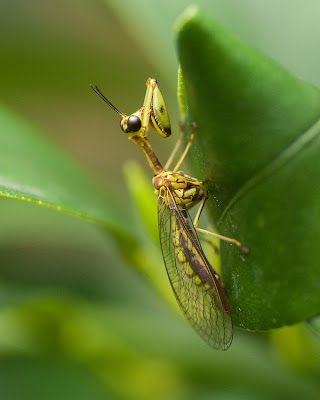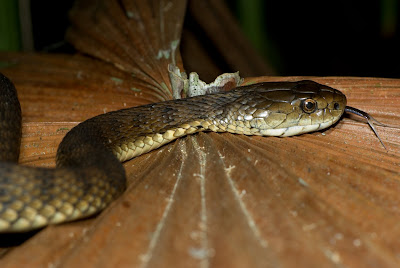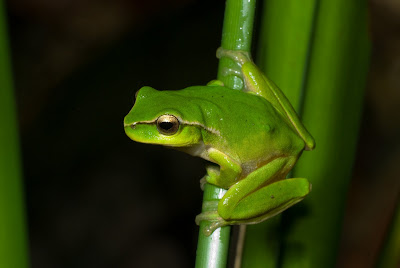Monday, October 22, 2007
Harlequin
Thursday, October 18, 2007
Mantispid
 Just spotted this little insect in the garden. It's a mantispid or mantis-fly. I'd forgive you if, after a casual glance, you were to call it a mantid, however it actually belongs in an entirely different order - Neuroptera - which contains the lacewings. I was going to write more info on these critters however the annotated budak has already done so. So click the link to see another species and find out more.
Just spotted this little insect in the garden. It's a mantispid or mantis-fly. I'd forgive you if, after a casual glance, you were to call it a mantid, however it actually belongs in an entirely different order - Neuroptera - which contains the lacewings. I was going to write more info on these critters however the annotated budak has already done so. So click the link to see another species and find out more.
Monday, October 15, 2007
Another successful field trip
Had the weekend away up in the vicinity of Smith's Lake - I normally go up there a couple of times a year and spend some time frogging, herping, insecting, birding etc. and generally see at least something of note. The trip this time was particularly noteworthy for two quite interesting reptiles.

The first was this dragon - the southern forest or angle-headed dragon (Hypsilurus spinipes). I'd never seen one of these before so was stoked to discover it in a patch of rainforest. It's a species that can be quite hard to spot due to its good camouflague and arboreal habits, luckily this one was just at knee-height clinging to a small tree-trunk.

The second reptile of note was a rough-scaled snake (Tropidechis carinatus), another 'lifer'* for me. This snake is known to be very venomous and is known to have caused human mortalities. We came across this individual sitting on a palm-frond just beside a pond - it's likely that it was sitting in wait for a frog to hop past.

This is the red-eyed treefrog (Litoria chloris). Only when it rains a lot does this species suddenly appear, breed, and disappear again. I suspect it lives the majority of its life in the canopy. Luckily we had some good rain and a few individuals showed up despite the somewhat cool temperatures.

Photographed here is Litoria barringtonensis, one of the frogs in that confusing group of green stream frogs. The black spots distinguish this species from...

... Litoria phyllochroa. Interesting to get these two species together at the one site. Despite their similar appearance they do have distinctive calls.
 Finally, a photograph of a spawn mass of the tusked frog (Adelotus brevis). Unlike the more familiar spawn of Limnodynastes species, the eggs of Adelotus are entirely unpigmented.
Finally, a photograph of a spawn mass of the tusked frog (Adelotus brevis). Unlike the more familiar spawn of Limnodynastes species, the eggs of Adelotus are entirely unpigmented.
The first was this dragon - the southern forest or angle-headed dragon (Hypsilurus spinipes). I'd never seen one of these before so was stoked to discover it in a patch of rainforest. It's a species that can be quite hard to spot due to its good camouflague and arboreal habits, luckily this one was just at knee-height clinging to a small tree-trunk.

The second reptile of note was a rough-scaled snake (Tropidechis carinatus), another 'lifer'* for me. This snake is known to be very venomous and is known to have caused human mortalities. We came across this individual sitting on a palm-frond just beside a pond - it's likely that it was sitting in wait for a frog to hop past.

This is the red-eyed treefrog (Litoria chloris). Only when it rains a lot does this species suddenly appear, breed, and disappear again. I suspect it lives the majority of its life in the canopy. Luckily we had some good rain and a few individuals showed up despite the somewhat cool temperatures.

Photographed here is Litoria barringtonensis, one of the frogs in that confusing group of green stream frogs. The black spots distinguish this species from...

... Litoria phyllochroa. Interesting to get these two species together at the one site. Despite their similar appearance they do have distinctive calls.
Tuesday, October 09, 2007
Inside the hive
I got my colony of the native stingless bee Trigona carbonaria in late November last year. The housing for Trigona is two half-boxes on top of each other, (an optional small third box can be placed on top for honey), so when a colony is doing well it can be 'split' by separating the two boxes and placing them on corresponding empty boxes.
My colony was a 'split', so it was composed of a full bottom box and an empty top box and 'honey super' on top, and seemed to be going very strong from the activity around the entrance. So, I thought I'd take the honey box off and see how the inner workings of the hive were going. Here are some photos from the event.
This is the main cavity of the box - you can see that it's nearly full of brood (the spiral structure up the top of the photo), pollen and nectar pots. Close-ups to follow.
This is the 'honey super' which sits on top. The piece of board in the photo below sits between this and the rest of the box cavity with small spaces at each end - the idea is that the brood spiral doesn't extend into the honey box, but honey and pollen are stored here, so the honey can be harvested without damaging the brood.
Divider board with amazing wax structure.
The spiral brood. Each little pot, when sealed, contains an egg or larva and enough supplies for it to develop into an adult. You can see some of the pots around the edges are open, still being stocked or waiting for the queen to oviposit.
Looks like the colony's doing very well - I expect they will stock the honey super more in the coming months, and it will be ready for a split before too long.
Subscribe to:
Posts (Atom)


